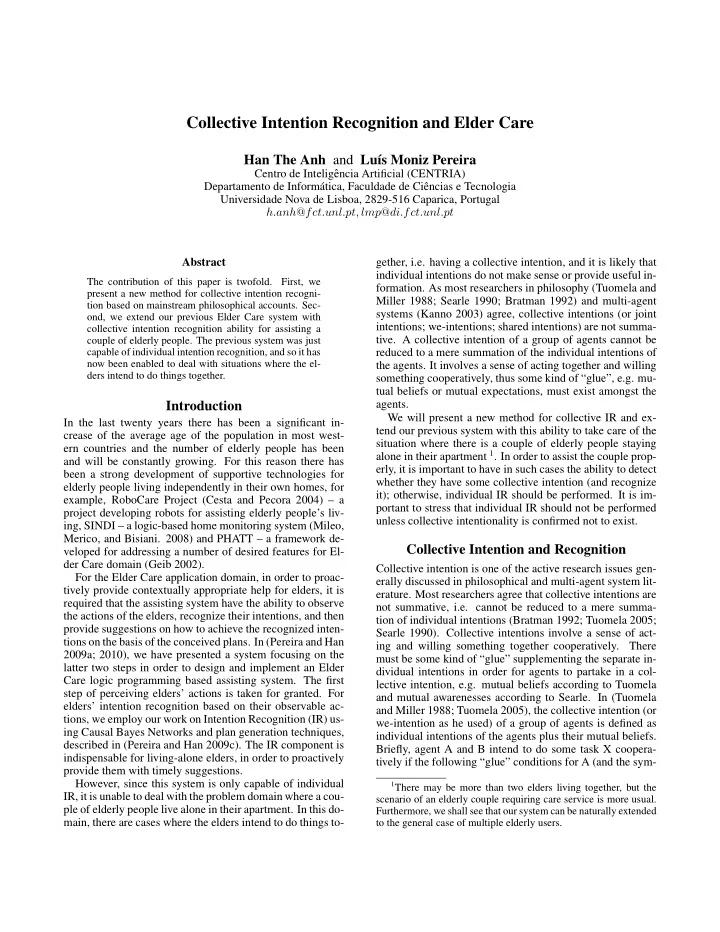

Collective Intention Recognition and Elder Care Han The Anh and Lu´ ıs Moniz Pereira Centro de Inteligˆ encia Artificial (CENTRIA) Departamento de Inform´ atica, Faculdade de Ciˆ encias e Tecnologia Universidade Nova de Lisboa, 2829-516 Caparica, Portugal h.anh @ fct.unl.pt, lmp @ di.fct.unl.pt Abstract gether, i.e. having a collective intention, and it is likely that individual intentions do not make sense or provide useful in- The contribution of this paper is twofold. First, we formation. As most researchers in philosophy (Tuomela and present a new method for collective intention recogni- Miller 1988; Searle 1990; Bratman 1992) and multi-agent tion based on mainstream philosophical accounts. Sec- systems (Kanno 2003) agree, collective intentions (or joint ond, we extend our previous Elder Care system with intentions; we-intentions; shared intentions) are not summa- collective intention recognition ability for assisting a tive. A collective intention of a group of agents cannot be couple of elderly people. The previous system was just capable of individual intention recognition, and so it has reduced to a mere summation of the individual intentions of now been enabled to deal with situations where the el- the agents. It involves a sense of acting together and willing ders intend to do things together. something cooperatively, thus some kind of “glue”, e.g. mu- tual beliefs or mutual expectations, must exist amongst the agents. Introduction We will present a new method for collective IR and ex- In the last twenty years there has been a significant in- tend our previous system with this ability to take care of the crease of the average age of the population in most west- situation where there is a couple of elderly people staying ern countries and the number of elderly people has been alone in their apartment 1 . In order to assist the couple prop- and will be constantly growing. For this reason there has erly, it is important to have in such cases the ability to detect been a strong development of supportive technologies for whether they have some collective intention (and recognize elderly people living independently in their own homes, for it); otherwise, individual IR should be performed. It is im- example, RoboCare Project (Cesta and Pecora 2004) – a portant to stress that individual IR should not be performed project developing robots for assisting elderly people’s liv- unless collective intentionality is confirmed not to exist. ing, SINDI – a logic-based home monitoring system (Mileo, Merico, and Bisiani. 2008) and PHATT – a framework de- Collective Intention and Recognition veloped for addressing a number of desired features for El- der Care domain (Geib 2002). Collective intention is one of the active research issues gen- For the Elder Care application domain, in order to proac- erally discussed in philosophical and multi-agent system lit- tively provide contextually appropriate help for elders, it is erature. Most researchers agree that collective intentions are required that the assisting system have the ability to observe not summative, i.e. cannot be reduced to a mere summa- the actions of the elders, recognize their intentions, and then tion of individual intentions (Bratman 1992; Tuomela 2005; provide suggestions on how to achieve the recognized inten- Searle 1990). Collective intentions involve a sense of act- tions on the basis of the conceived plans. In (Pereira and Han ing and willing something together cooperatively. There 2009a; 2010), we have presented a system focusing on the must be some kind of “glue” supplementing the separate in- latter two steps in order to design and implement an Elder dividual intentions in order for agents to partake in a col- Care logic programming based assisting system. The first lective intention, e.g. mutual beliefs according to Tuomela step of perceiving elders’ actions is taken for granted. For and mutual awarenesses according to Searle. In (Tuomela elders’ intention recognition based on their observable ac- and Miller 1988; Tuomela 2005), the collective intention (or tions, we employ our work on Intention Recognition (IR) us- we-intention as he used) of a group of agents is defined as ing Causal Bayes Networks and plan generation techniques, individual intentions of the agents plus their mutual beliefs. described in (Pereira and Han 2009c). The IR component is Briefly, agent A and B intend to do some task X coopera- indispensable for living-alone elders, in order to proactively tively if the following “glue” conditions for A (and the sym- provide them with timely suggestions. However, since this system is only capable of individual 1 There may be more than two elders living together, but the IR, it is unable to deal with the problem domain where a cou- scenario of an elderly couple requiring care service is more usual. ple of elderly people live alone in their apartment. In this do- Furthermore, we shall see that our system can be naturally extended main, there are cases where the elders intend to do things to- to the general case of multiple elderly users.
Recommend
More recommend